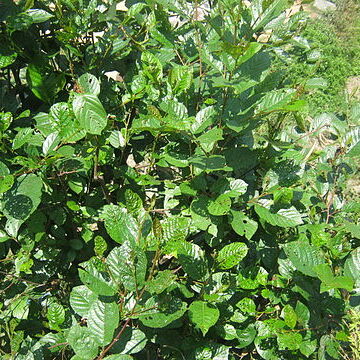Trees to 15 m tall; bark gray or dark gray, smooth. Branchlets dark brown, sparsely yellow pubescent when young, glabrescent. Buds stipitate, with 2 glabrous, ribbed scales. Petiole robust, 1-2.5 cm, subglabrous; leaf blade obovate-lanceolate, obovate-oblong, ovate, or elliptic, 4-16 × 2.5-10 cm, abaxially with dense, resinous glands, yellow pubescent along veins, bearded in axils of lateral veins, adaxially glabrous, base cuneate or broadly cuneate, rarely subrounded, margin entire or remotely minutely serrate, apex abrupt or acute, rarely acuminate; lateral veins 8-16 on each side of midvein. Female inflorescences numerous, in a panicle, ellipsoid, 2-2.2 cm × 7-8 mm; peduncle robust, 2-8 mm, glabrous; bracts ca. 4 mm, woody, persistent, base cuneate, apex rounded, 5-lobed. Nutlet oblong, ca. 2 mm, with membranous wings ca. 1/2 as wide as nutlet. Fl. May-Jun, fr. Jul-Sep. 2n = 28, 56.
More
Tree, 8-15 m; timber white; twigs glabrescent, ribbed, hardly triangular. Leaves spiral, ovate to oblong, acute or short-acuminate, rounded or cuneate at the base, 7-21 by 4-10 cm; nerves 12-16 pairs, beneath as the prominent crossbar-veins laxly puberulous (glabrescent) and vein-axils bearded; midrib and nerves sulcate and glabrous above; petiole strong, c. 5-10 times as short as the blade, 1½-2 cm. Male catkins up to 10 cm by 3-5 mm, in a terminal panicle up to 16 cm. Female inflorescences short, axillary, bearing 3-8 oblong, 3-6 mm peduncled catkins 10-17 by 6-7 mm. Nuts obtrapezoid, emarginate, incl. the wing 2 mm through, crowned by the style base.
Forests in ravines, on stream banks and occasionally in drier localities, 900-2,700 metres in the Himalayas. Riverbanks or village margins, often forming pure stands, at elevations of 200-2,800 metres in China.
More
Forests in ravines, on stream banks and occasionally in drier localities, 900-2,700 metres in the Himalayas. Riverbanks or village margins, often forming pure stands, at elevations of 200-2,800 metres in China.
It is a temperate plant. Arboretum Tasmania.
Can be grown by cuttings or seedlings. Seeds needs soaking.


